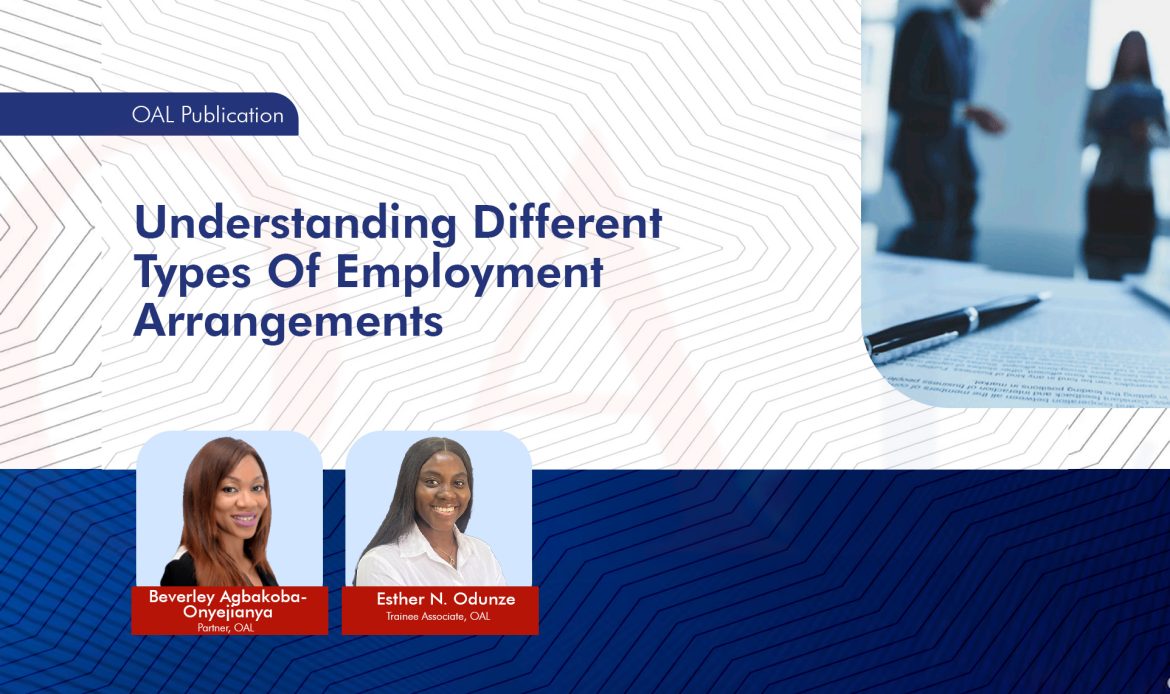
There are different arrangements as it relates to employment. It is important to understand the different types of employment statuses that exist, and the differences in obligations for employers and recruiters e.g. wages, and entitlements for each arrangement. This article will explain the different work arrangements and the entitlements under each.
TYPES OF EMPLOYMENT
FULL-TIME PERMANENT EMPLOYMENT (Regular employees)
Permanent employment may either be full-time or part-time. A full-time employee’s actual hours of work are agreed between the employer. They generally work 40 hours per week, plus reasonable additional hours. As permanent staff, they have job security since there is no predetermined end date to their employment. In addition to their wages, they often receive benefits like health insurance, retirement savings plans, gym memberships and paid vacations. Permanent employees are often eligible to switch job positions within their companies.
They are entitled to all the leave entitlements. This includes annual leave, sick leave and carers leave- all paid. They are also entitled to public holiday pay if the holiday falls on a day they would usually work. A full-time employee’s pay is usually based on an annual salary outlined in their employment agreement. The employment agreement typically sets out the notice period for termination of employment. The notice period is usually 4 weeks but varies depending on the agreement between employer and employee.
PART-TIME EMPLOYMENT
Part-time employees often work for a company for less than 30 hours per week. They put in fewer regular hours than full-time workers do. They may be permanent staff and thus, share the same rights and obligations as full-time employees. They receive the same wages and conditions as full-time employees on a proportionate basis- according to the hours they work. They might work irregular shifts or consistently on fixed days of the week, like part-time nurses and shop employees.
Part-time employees differ from full-time permanent employees in that they generally work fewer hours per week than regular employees. In addition, they are more likely to be let go before full-time employees, who often require more training and have had a more significant investment made into their onboarding.
FIXED-TERM EMPLOYEE/CONTRACT STAFF
Fixed-term employment is a contract in which a company hires an employee for a specific period of time. They are identifiable by having a set end date, usually by reference to a specific date or on completion of a given task. It is usually for a year but can be renewed after the term expires depending on the requirement. Under the fixed-term employment contract, the payout or the payment is fixed in advance and is not altered till the term expires. More often than not, the employee is not on the payroll of the company.
The aim of taking on fixed-term employees is for employers to bring in people with special skills or employ extra labour when it is needed. In fact, many companies might hire a person on contract for a year and make them permanent after the term expires. The company sees the potential of the person before taking him or her on the payroll of the company.
In IT companies especially, professionals are hired on a contractual basis to complete a specific project. They could be absorbed into the company later when the project is completed. In some companies, fixed-term employees are paid more than permanent staff, either because of their special skills or to compensate for the temporary nature of the job.
Generally, fixed-term employees have the same entitlements as permanent full-time or part-time employees. The significant distinction between fixed-term employment and that of permanent employees is that the former is for a fixed term or for the duration of a specific project as opposed to an ongoing employment arrangement.
Also read: Why SMEs Need Data Protection Compliance Organisation (DPCO)
CASUAL EMPLOYMENT
Casual work arrangement is generally used to describe work arrangements which do not fall within the traditional definition of employment. Casual workers are engaged on an irregular basis according to business demands. Simply put, it is often temporary and characterised by uncertain wages, long hours, and a lack of job security. There is no sick or annual leave pay. Casual employment has no end date and can be terminated with no notice from either party. If you are in doubt about whether a work arrangement is casual, below are a few questions to answer for better understanding and clarity:
- What is the degree of certainty that the employment will continue
- Who Has control and what is the level of control over the labour process (working conditions, wages, and the pace of work);
- The income
- The amount of entitlement and the degree of regulatory protection
Summarily, a casual employee:
- accepts a job with the understanding that there is no firm commitment to regular employment
- usually would work fewer hours than regular employees
- do not receive paid days off
- typically is not entitled to a notice of termination unless it is stated in their employment contract
The casualization of employment is a common work arrangement globally. In the attempt to cut down the organisational costs of employees, employers in Nigeria are increasingly filling positions in their organisations, which ought to be permanent, with casual employees. The increasing rate of unemployment and underemployment has to a great extent contributed to the increasing rate of employment casualization and this has been aggravated by the declining global economy. Many job seekers agree to this arrangement due to their fear of rejection as well as the pressure and stress of changing jobs.
Under Nigerian Labour Law, a casual employee is defined as a worker engaged for a period of less than 6 months and who is paid at the end of each day. Unfortunately, this is currently not the practice as you see casual workers who have been engaged for as long as one or two years. It is noteworthy that there is a Bill to amend the extant Labour Act, which has been passed by the House of Representatives, to prohibit and criminalise the casualisation of workers after six months of engagement. The Bill, when assented to, would mandate the regularisation of employees after six months of employment.
APPRENTICES, INTERNS AND TRAINEES
Apprenticeships and traineeships are types of formal training arrangements that combine work with study for a qualification in a trade or occupation. The aim is for such workers to gain practical work experience and on-the-job training. It can be done on a full-time or part-time basis, depending on the circumstances. An apprentice or trainee is usually entitled to notice of termination unless they are dismissed for serious misconduct. This work arrangement may be for 1 to 3 years or more.
Internships, on the other hand, are usually short-term arrangements (done during holidays or the course of a project). It is a temporary professional learning opportunity for a student or recent graduate who wishes to gain experience in a specific field. Some internships provide wages and benefits while others do not. These work arrangements might not provide the same wages and benefits as full-time employment, but they can still help the worker cover some expenses such as work clothing, commuting and lunches).
RECENT GLOBAL WORK TRENDS
When the COVID-19 pandemic swept across the globe and social distancing was necessary to reduce the spread of the virus, many governments strongly encouraged or mandated minimising physical presence at work. This created a sudden need for businesses and their employees to start or increase working from home.
In response, a large number of businesses turned to digital technology to continue operations, with personnel working from home and using tools such as videoconferencing, cloud services and virtual private networks. Even the Courts of Justice were not left behind in the innovation. This led to new work arrangements like Remote arrangements, Hybrid arrangements and Freelancing.
REMOTE WORK (WORK FROM HOME)
Remote work is the practice of employees doing their jobs from a location other than a central office operated by the employer. It simply means you are working for your employer while staying at home. Such locations could include an employee’s home, a co-working or other shared space, a private office, or any other place outside of the traditional corporate office building or campus. It has remained popular even after the pandemic because it offers benefits for both employers and employees alike. It does away with the expenditures associated with maintaining a physical workspace, hiring and recruiting and the time, stress, and money associated with commuting. It has also demonstrably improved employee productivity.
HYBRID WORK
Hybrid work is a flexible work strategy which combines working from home and an office setting. Hybrid working varies in flexibility and can accommodate a range of diverse work schedules. It gives workers the freedom to decide how and where they work and gives them the liberty to plan their workweek in a way that complies with both corporate standards and their personal needs.
Employers who utilise a hybrid work style can provide their staff with a better work-life balance. In turn, this increases productivity and employee engagement at work, which makes organisations run more effectively.
FREELANCING
Freelancing is a contract-based profession where instead of being employed by an organisation, a person who works as a freelancer uses his or her skills and experience to serve a variety of clients. Working remotely does not necessarily mean you are working as a freelancer. In reality, freelancing is a career job choice in itself. As a freelancer, you run your own business. As a remote worker, you may choose to run your own business or simply work for a stable company full-time in a remote location. Simply put, freelancing is when you work with different clients and accept a variety of jobs without committing to a single employer. The quantity of assignments or jobs you can take on simply depends on your capacity to do them as required.
CHALLENGES THAT MAY ARISE UNDER EMPLOYMENT
Managing employment risk is one of the biggest commercial concerns for businesses. Employers frequently neglect risk management because they are so focused on expanding their businesses that they forget that these risks might place a firm in a precarious situation and possibly lead to an expensive lawsuit or legal fees. Some of the pitfalls include:
- Failure to have properly drafted employment contract with a defined scope
- No job description
- Failure to pay wages timely
- Excessive disciplinary action
- Poor employee welfare; toxic working culture, bad leadership
Many employers raise their risk further by not having a company handbook or written best practices and procedures. This can work against the employer if an employee ever files a claim. It should be noted that disputes involving employment are handled at the National Industrial Court. The National Industrial Court has exclusive jurisdiction in civil cases and matters related or connected with any labour, employment, trade union, industrial relations and matters arising from the workplace, the condition of service including health, safety, the welfare of labour, employee, workers and matters incidental to employment.
In conclusion, employers must understand the nature of the vacancy they are hiring for and should have proper job descriptions for each role and hire accordingly. It is very important to engage the services of a competent legal/HR advisor to draft an employment contract which aligns with Nigerian Labour Law and is tailored to their business needs.
